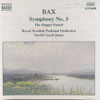Bax Symphony No 3. Happy Forest.
The third instalment in David Lloyd-Jones's Bax series with some fine playing from the Scottish orchestra
View record and artist detailsRecord and Artist Details
Composer or Director: Arnold (Edward Trevor) Bax
Genre:
Orchestral
Label: Naxos
Magazine Review Date: 2/2000
Media Format: CD or Download
Media Runtime: 54
Mastering:
DDD
Catalogue Number: 8 553608

Tracks:
| Composition | Artist Credit |
|---|---|
| Symphony No. 3 |
Arnold (Edward Trevor) Bax, Composer
Arnold (Edward Trevor) Bax, Composer David Lloyd-Jones, Conductor Royal Scottish National Orchestra |
| (The) Happy Forest |
Arnold (Edward Trevor) Bax, Composer
Arnold (Edward Trevor) Bax, Composer David Lloyd-Jones, Conductor Royal Scottish National Orchestra |
Author: Andrew Achenbach
Completed in Morar during the winter of 1928-29 and dedicated to Sir Henry Wood, Bax's Third Symphony boasts arguably the richest store of memorable melodic invention to be found in any of the composer's cycle of seven, culminating in an inspired epilogue of wondrous, jaw-dropping beauty. Once again, I am mightily impressed by David Lloyd-Jones's clear-headed, purposeful conducting of this intoxicating repertoire: for my money, his is the most judiciously paced and satisfyingly cogent Bax Third we've had since Sir John Barbirolli's pioneering 1943-44 Halle account (EMI, 4/92 - nla). Moreover, not only does Lloyd-Jones keep a firmer hand on the tiller than either Bryden Thomson or Sir Edward Downes (RCA, 10/69 - nla), he also draws some enthusiastic playing from the RSNO, which responds throughout with commendable polish and keen application.
In the symphony's mistily atmospheric introduction I appreciate the watchful sensitivity of the RSNO winds and brass in their tendril-like arabesques, as well as the bracing rhythmic resilience of any faster music - and how touchingly Lloyd-Jones shapes the strings' wistful Lento moderato second subject. Some Baxians may feel that the brakes are applied too steeply at that tricky Poco meno mosso marking at three bars before fig 49 (15'48''), but the exhilarating coda certainly goes with terrific zest and gallumphing swagger. Finely poised, affectingly full-throated solo work from principal horn and trumpet illuminates the progress of the ensuing Lento, whose ravishing (yet never entirely untroubled) landscape Lloyd-Jones characteristically surveys in less lingering fashion than either Barbirolli or Thomson. The first half of the finale, too, is a great success, Lloyd-Jones negotiating the fiendish twists and turns dictated by Bax's copious tempo markings with impressive aplomb. Only in the epilogue (surely one of the most hauntingly lovely visions in all British music) did I feel the need for a touch more rapt poetry: as it stands, the resulting ever-so-slight whiff of literalness ensures a slightly lower tingle-rating than is customary during these unforgettable pages.
One other parting observation: in the third bar after fig 21 in the finale (6'15''), the bass-drum player enters one crotchet earlier than marked - a tiny blot on an otherwise highly laudable achievement.
Tim Handley's excellently balanced recording is rich and refined, though the perspective is perhaps fractionally closer than ideal for The Happy Forest, which receives a performance of bounding, almost Coatesian vigour, gleeful mischief and muscular fibre; just that last, crucial drop of enchantment remains elusive. No matter, a disc not to be missed.'
In the symphony's mistily atmospheric introduction I appreciate the watchful sensitivity of the RSNO winds and brass in their tendril-like arabesques, as well as the bracing rhythmic resilience of any faster music - and how touchingly Lloyd-Jones shapes the strings' wistful Lento moderato second subject. Some Baxians may feel that the brakes are applied too steeply at that tricky Poco meno mosso marking at three bars before fig 49 (15'48''), but the exhilarating coda certainly goes with terrific zest and gallumphing swagger. Finely poised, affectingly full-throated solo work from principal horn and trumpet illuminates the progress of the ensuing Lento, whose ravishing (yet never entirely untroubled) landscape Lloyd-Jones characteristically surveys in less lingering fashion than either Barbirolli or Thomson. The first half of the finale, too, is a great success, Lloyd-Jones negotiating the fiendish twists and turns dictated by Bax's copious tempo markings with impressive aplomb. Only in the epilogue (surely one of the most hauntingly lovely visions in all British music) did I feel the need for a touch more rapt poetry: as it stands, the resulting ever-so-slight whiff of literalness ensures a slightly lower tingle-rating than is customary during these unforgettable pages.
One other parting observation: in the third bar after fig 21 in the finale (6'15''), the bass-drum player enters one crotchet earlier than marked - a tiny blot on an otherwise highly laudable achievement.
Tim Handley's excellently balanced recording is rich and refined, though the perspective is perhaps fractionally closer than ideal for The Happy Forest, which receives a performance of bounding, almost Coatesian vigour, gleeful mischief and muscular fibre; just that last, crucial drop of enchantment remains elusive. No matter, a disc not to be missed.'
Discover the world's largest classical music catalogue with Presto Music.

Gramophone Digital Club
- Digital Edition
- Digital Archive
- Reviews Database
- Full website access
From £8.75 / month
Subscribe
Gramophone Full Club
- Print Edition
- Digital Edition
- Digital Archive
- Reviews Database
- Full website access
From £11.00 / month
Subscribe
If you are a library, university or other organisation that would be interested in an institutional subscription to Gramophone please click here for further information.




